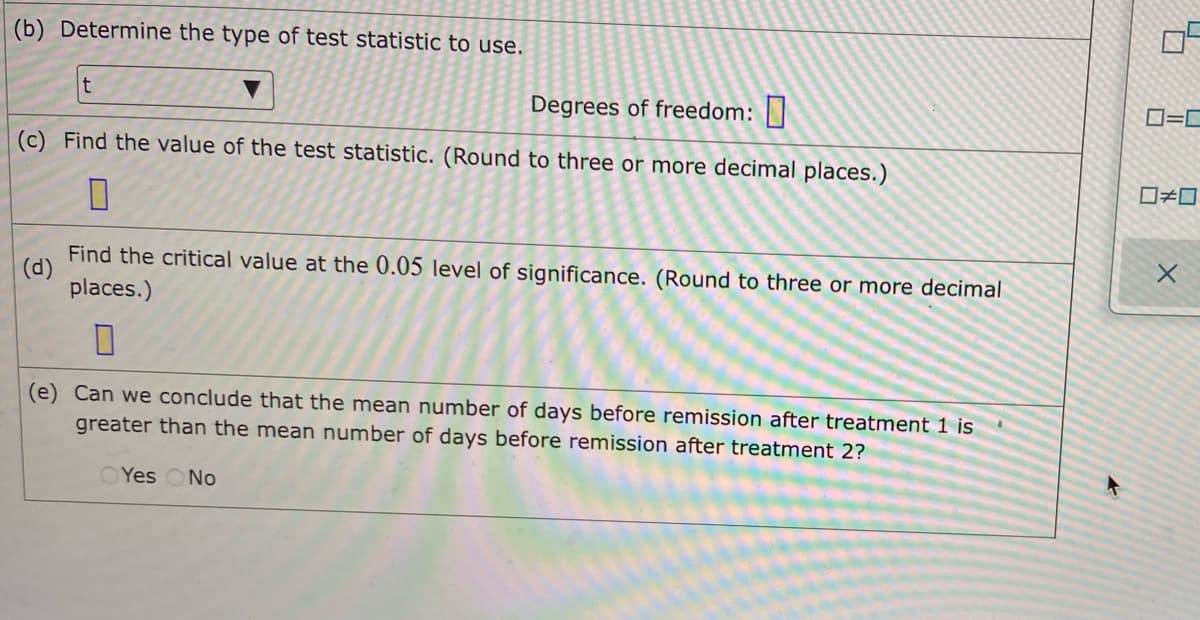Medical researchers are interested in determining the relative effectiveness of two drug treatments on patients with a chronic mental illness. Treatment 1 has been around for many years, while treatment 2 has recently been developed based on the latest research. The researchers chose two independent test groups. The first group had 10 patients, all of whom received treatment 1 and had a mean time until remission of 188 days, with a standard deviation of 8 days. The second group had 14 patients, all of whom received treatment 2 and had a mean time until remission of 185 days, with a standard deviation of 5 days. Assume that the populations of times until remission for each of the two treatments are normally distributed with equal variance. Can we conclude, at the 0.05 level of significance, that µ,, the mean number of days until remission after treatment 1, is greater than U, the mean number of days until remission after treatment 2? Perform a one-tailed test. Then complete the parts below. Carry your intermediate computations to three or more decimal places and round your answers as specified in the table. (If necessary, consult a list of formulas.)
Medical researchers are interested in determining the relative effectiveness of two drug treatments on patients with a chronic mental illness. Treatment 1 has been around for many years, while treatment 2 has recently been developed based on the latest research. The researchers chose two independent test groups. The first group had 10 patients, all of whom received treatment 1 and had a mean time until remission of 188 days, with a standard deviation of 8 days. The second group had 14 patients, all of whom received treatment 2 and had a mean time until remission of 185 days, with a standard deviation of 5 days. Assume that the populations of times until remission for each of the two treatments are normally distributed with equal variance. Can we conclude, at the 0.05 level of significance, that µ,, the mean number of days until remission after treatment 1, is greater than U, the mean number of days until remission after treatment 2? Perform a one-tailed test. Then complete the parts below. Carry your intermediate computations to three or more decimal places and round your answers as specified in the table. (If necessary, consult a list of formulas.)
A First Course in Probability (10th Edition)
10th Edition
ISBN:9780134753119
Author:Sheldon Ross
Publisher:Sheldon Ross
Chapter1: Combinatorial Analysis
Section: Chapter Questions
Problem 1.1P: a. How many different 7-place license plates are possible if the first 2 places are for letters and...
Related questions
Question

Transcribed Image Text:Medical researchers are interested in determining the relative effectiveness of two drug treatments on patients with a chronic mental
illness. Treatment 1 has been around for many years, while treatment 2 has recently been developed based on the latest research. The
researchers chose two independent test groups. The first group had 10 patients, all of whom received treatment 1 and had a mean time
until remission of 188 days, with a standard deviation of 8 days. The second group had 14 patients, all of whom received treatment 2
and had a mean time until remission of 185 days, with a standard deviation of 5 days.
Assume that the populations of times until remission for each of the two treatments are normally distributed with equal variance.
Can we conclude, at the 0.05 level of significance, that µ,, the mean number of days until remission after treatment 1, is greater than
H, the mean number of days until remission after treatment 2?
Perform a one-tailed test. Then complete the parts below.
Carry your intermediate computations to three or more decimal places and round your answers as specified in the table. (If necessary,
consult a list of formulas.)

Transcribed Image Text:(b) Determine the type of test statistic to use.
Degrees of freedom: | |
D=C
|(c) Find the value of the test statistic. (Round to three or more decimal places.)
O#0
Find the critical value at the 0.05 level of significance. (Round to three or more decimal
(d)
places.)
(e) Can we conclude that the mean number of days before remission after treatment 1 is
greater than the mean number of days before remission after treatment 2?
OYes ONo
Expert Solution
This question has been solved!
Explore an expertly crafted, step-by-step solution for a thorough understanding of key concepts.
This is a popular solution!
Trending now
This is a popular solution!
Step by step
Solved in 3 steps with 2 images

Recommended textbooks for you

A First Course in Probability (10th Edition)
Probability
ISBN:
9780134753119
Author:
Sheldon Ross
Publisher:
PEARSON


A First Course in Probability (10th Edition)
Probability
ISBN:
9780134753119
Author:
Sheldon Ross
Publisher:
PEARSON
